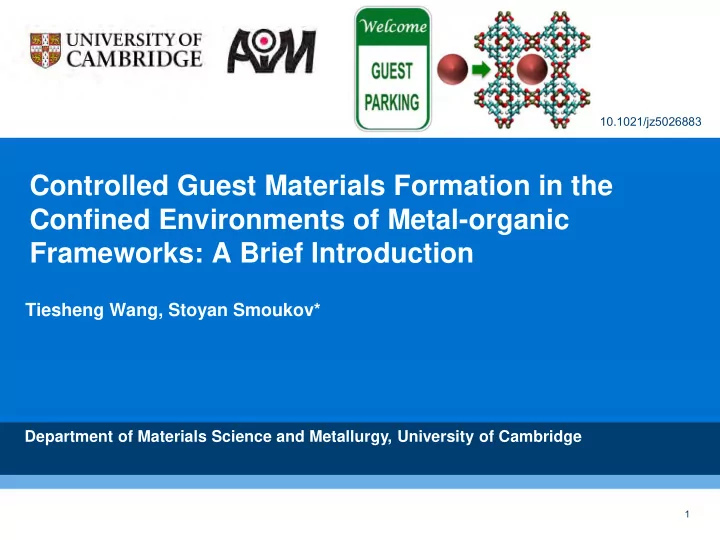

10.1021/jz5026883 Controlled Guest Materials Formation in the Confined Environments of Metal-organic Frameworks: A Brief Introduction Tiesheng Wang, Stoyan Smoukov* Department of Materials Science and Metallurgy, University of Cambridge 1
Nomenclatures: Metal-organic Frameworks (MOFs) and the Guests Functional part Channel cavity Organic linker (ligand) 10.1039/c6cs00250a Common Features: • Crystal-like • Porous (typical pore 10.1021/cm502594j dimension: 0.5-2.5 nm) 2
Guests in the MOFs: An Emerging Field 1. Guest-Induced Emergent Properties Facilitates light harvesting Facilitates light harvesting (e.g. photoluminescence) (e.g. photoluminescence) 10.1021/jz5026883 2. Potentially used for catalysis, hydrogen storage etc. MOF prohibits conglomeration and 10.1021/nn304514c 10.1021/ja807357r deactivation of polyoxometalates MOF-confined NaAlH 4 hydrogen storage catalysts • Guest-host (MOF) interaction can lead to positive 3 confinement/synergistic effect .
How to Put Guest Species inside MOFs? Direct impregnation (e.g. G G enzyme@MOF) MOF synthesised in presence of guest Achieving guest species species or their precursors(e.g. in MOF polyoxometalate (POM) @MOF) G G Guest species formed locally ( in situ ?) Challenges related to controlled guest materials A+B G formation locally: A G B A • Precursor/intermediate impregnation • MOF degradation • Place that guest materials can formed (i.e. only inside? Or both inside and outside ?) • Guest materials morphology • Porosity after the guests incorporation • And the list carries on… 4
Inorganic Materials inside MOF: an Overview Metal/Alloy/intermetallic composite A quite mature field 10.1038/ncomms9248 Metal oxide/ polyoxometalate A medium mature field 10.1021/jacs.5b00075 Other metallic compounds (e.g. Rarely studied sulphides, phosphides) 10.1007/s12274-014-0690-x General routes to achieve inorganic materials inside (and outside) MOF: • Wet-chemistry: redox reaction • Wet-chemistry: decomposition (maybe followed by a redox reaction) • Vapour-phase deposition followed by decomposition or redox reaction 5
Controlled Precursor Impregnation 10.1021/ja3043905 10.1002/anie.200705998 Functional part of MOF is used Double solvent method: guiding to attract and immobilised the metal salt to the hydrophilic metal precursor. MOF in a more hydrophobic medium. 6
Controlled Material Formation Process II 10.1002/smll.201401875 Different reducing agent may lead to different guest materials. Formed In Formed In Formed In acetone acetic acid water 10.1021/nn5072446 Solvent may influence the morphology of the guest material. 7
Vinyl-based Oligomers/Polymers inside MOF Vinyl group 10.1002/anie.200700242 10.1039/b802583p 8
Conducting Oligomers/Polymers inside MOF Vapour Liquid phase, phase, oxidising oxidising agent used agent used 10.1039/C6MH00230G 10.1021/jacs.6b05552 9
Controlled MOF-MOF interpenetration solvent Temperature/ concentration 10.1021/ja906911q Controlled 10.1002/anie.201202925 Interpenetration Growth method Ligand used liquid phase 10.1021/ja909519e epitaxial 10.1038/nmat2445 growth Controlling the MOF-MOF interpenetration is a 10 challenge for MOF synthesis.
Potential Hybrid (CH 3 NH 3 PbI 3 , MAPI) Perovskite Incorporated inside A MOF MAPI on glass 180 °C , 0.001 torr, 10 hours +PbI 2 MAI/DMSO/GBL 180 °C , 0.001 • Hybrid ervoskite can be synthesised by removing the solvent. torr, 10 hours • It will decompose to PbI 2 to if the temperature is too high – methylamine (MA) can be removed – the major issue for the 11 stability of hybrid perovskite solar cell . Unpublished work PbI 2 @MOF Temperature applied is used to control the potential formation of MAPI only inside the MOF. 11
Conclusion empty space to accommodate guests. Small pore dimension - guests can be immobilised and dispersed in MOF, also confinement effect MOF with tuneable chemistry; Positive guest-host (MOF) interaction can lead to synergistic effect . Some typical approaches to control various materials incorporating into (sometimes also onto) MOFs. Factors like dimensions in space, physical/chemical interactions and other physical/chemical properties (e.g. thermal stability) need to be taken into account. 12
Thank you! Dr Stoyan Smoukov , Prof. Anthony K. Cheetham FRS, Dr Yue Wu, Dr Tongtong Zhu, Dr Weiwei Li & Ms Shijing Sun Department of Materials Science & Metallurgy Prof. Daping Chu Centre for Advanced Photonics and Electronics, Department of Engineering Prof. Clemens Kaminski & Dr Oliver Hadeler EPSRC Centre for Doctoral Training in Sensor Technologies and Applications Prof. John Madden & Dr Meisam Farajollahi Advanced Materials and Process Engineering Laboratory Prof. Xinhe Bao, Prof. Qiang Fu, Ms Lijun Gao State Key Laboratory of Catalysis Dr Sebastian Henke Faculty of Chemistry Dr Sneha R Bajpe Inorganic Chemistry Laboratory Dr Martyn McLachlan & Mr Jiaqi Zhang Department of Materials 13
Some Concepts about MOF Metal Node: Functional part SUMOF-1 NU-1000 10.1038/nmat4238 10.1039/C4CS00067F Organic linker Organic linker (ligand): (ligand) 10.1039/C3CS60404G Benzene-1,4-dicarboxylic acid 4 4'-bipyridine cavity Channel 14
Controlled Reducing Agent Impregnation: A Novel Way to Incorporate Active Metallic Compound inside the MOF Thermal Gravimetric Analysis 10.1021/nn1010182 Elevated T applied to reducing agent impregnation remove reducing agent KMnO 4 (aq) on the surface Mn x O y cluster embedded in Reducing agent (EDOT) TW-2 Reducing agent (EDOT) the organic matrix of (the MOF EDOT@ TW-2 produced by reducing Excess_EDOT@ TW-2 used) agent Additionally, the reducing agent is MnO 2 _base_guest@ TW-2 trapped inside the MOF as it is Unpublished work immiscible with water. • An alternative way to control reagent impregnation and reaction in the MOF system. • 15 Allow some metal oxides to be synthesised in MOF, which can be difficult to achieve otherwise.
Controlled Reducing Agent Impregnation: A Novel Way to Incorporate Active Metallic Compound inside the MOF II EDS elemental analysis on the pure MOF EDS elemental analysis on MnO 2 _base_guest@ TW-2 Nitrogen Powder XRD isothermal Catalyst for CO oxidation Unpublished work 16
Appendix Control in Bottle-around-the-ship Approach Particles can be encapsulated in MOF via surface modification. The particle distribution inside the MOF can also be controlled. 10.1021/ja109659k 10.1038/nchem.1272 A typical polyoxometalate (POM)@MOF. 17
Ca. 1.5 nm 10.1038/natrevmats.2015.18 Ca. 2.4 nm 10.1021/cg301691d cubic Fm3̅m, a = 39.120(5) Å Zr 6 C 28 H 16 O 28 S 4 (M = 1476.0 g mol ) 18
appendix 19
appendix 20
appendix 21
appendix Decomposed MAPI 10.1038/nmat4014
Recommend
More recommend